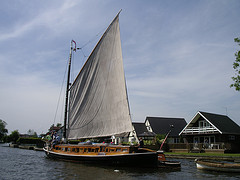Wherry
Wherries were clinker-built with long overhanging bows so that patrons could step ashore dryshod before landing stages were built along the river.The Sporting Magazine describes an event on 6 August 1795 as "the contest for the annual wherry given by the Proprietors of Vauxhall by six pairs of oars in three heats".In 1822 Bell's Life reported on a contest on 30 June between eight watermen belonging to the Temple Stairs for "a prize wherry given by the gentlemen of the Inns of Court" and on 31 July "the anniversary of the Grand Aquatic Regatta of the inhabitants of Queenhithe", when "a handsome Wherry" and other prizes were contended for by "six of the free watermen belonging to those stairs".[11] In North America, particularly in the Penobscot Bay region of the Gulf of Maine, wherries became the preferred boat for the longshore Atlantic salmon fishery.[12] They are generally long and narrow, with a straight stem, a wineglass stern and usually carvel planked (smooth sides).


Kingston upon ThamesNorfolk wherryRiver BureriverscanalsEnglandRiver ThamesRiver CamBroadland riversNorfolkSuffolkTyne & Wear Archives & MuseumsThames skiffclinker-builtcutterRoyal NavyCambridgeDaniel DefoepuntingCambridge UniversityCoverdale BibleBook of EzekieltidewayLondonwater taxiswatermenElizabethanAct of ParliamentGlobe TheatreInns of CourtQueenhitheWestminsterVauxhallPenobscot BayGulf of MaineAtlantic salmonJohn GardnerFine boatsCoxless pairCoxed pairCoxless fourCoxed fourScullingSingle scullDouble scullQuad scullOctuple scullDgħajsaFrejgatinaGondolaKajjikSampan panjangSandoloThames racing skiffCornish pilot gigCurrachSurfboatTraineraCeltic longboatOcean rowing